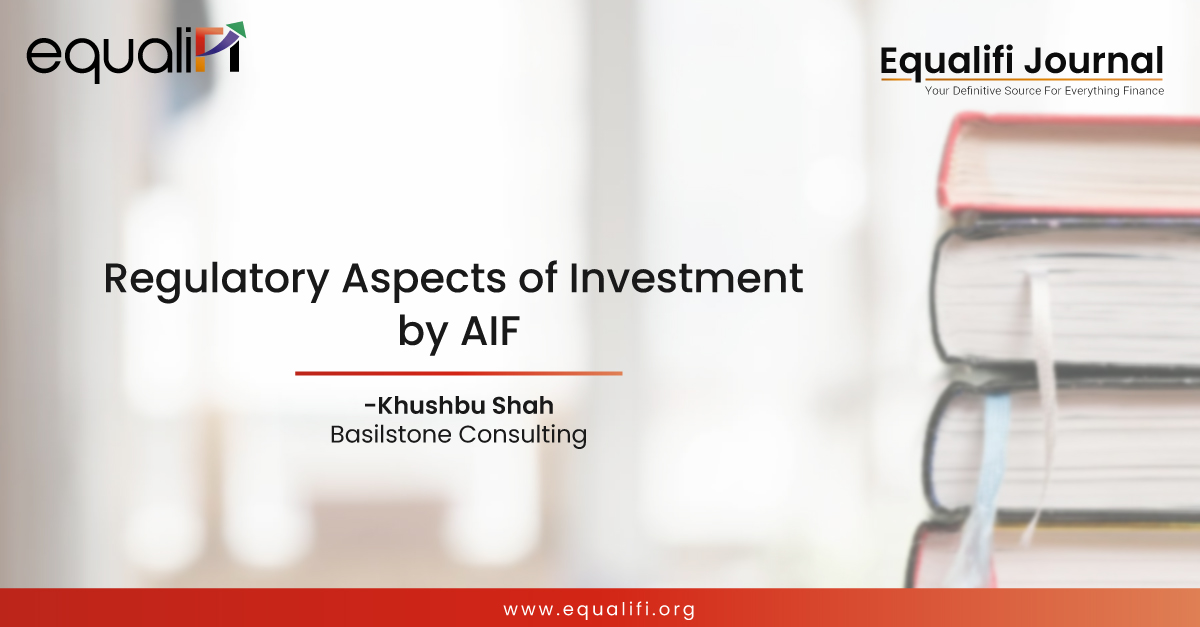Regulatory Aspects of Investment by AIF
Posted on: February 2, 2024 | By: Khushbu Shah, Khushbu Shah
SEBI introduced the concept for AIFs on August 1, 2011, by way of a white paper and proposed to regulate all funds established in India which are privately pooled investment vehicles raising funds from Indian or foreign investors. The SEBI (Alternative Investment Funds) Regulations, 2012 (‘AIF Regulations’) were introduced to the Indian market on May 21, 2012 and over the years, many noteworthy changes have been introduced to the AIF regulations to make it more robust and relevant across the global market.
In 2012, the regulatory authorities introduced various categories of alternate investment funds (AIFs) with the objective of developing a range of specialized and boutique products tailored for high-net-worth individuals (HNI). Prior to the introduction of AIFs, conventional investment options included mutual funds and portfolio management services. The concept of alternate investment funds was officially launched in 2012 to offer a distinct and regulated investment approach, catering specifically to the needs of sophisticated investors.
Alternative Investment Funds are broadly classified into 3 categories viz. Category I, Category II and Category III Alternative Investment Funds.
Category I (Cat I) AIF invests in start-up or early-stage ventures or social ventures or SMEs or infrastructure or other sectors or areas which the government or regulators consider as socially or economically desirable and shall include venture capital funds, SME Funds, social impact funds, infrastructure funds, special situation funds and such other Alternative Investment Funds as may be specified.
Category II (Cat II) AIF is one which does not fall in Category I and III and which does not undertake leverage or borrowing other than to meet day-to-day operational requirements and as permitted in under regulations. Private equity funds or Debt funds for which no specific incentives or concessions are given by the government or any other Regulator can be classified as Cat II AIF.
Category III (Cat III) AIF employs diverse or complex trading strategies and may employ leverage including investment in listed or unlisted derivatives.
Based on the category of AIF, the fund can invest in various investment products, subject to regulatory guidelines briefly discussed as under: –
- Investment made by AIF in Derivative Instruments
Derivative instruments can be used to generate gains or hedge existing investments. Derivatives may amount to utilisation of leverage due to the nature of instrument. The leverage of a Category III AIF shall not exceed 2 times of the NAV of the AIF. i.e. if an AIF’s NAV is Rs.100 crore, its exposure (Longs + Shorts) after offsetting positions as permitted shall not exceed Rs.200 crore. The NAV for the purpose of computing the amount of leverage allowed shall exclude investment in other AIFs. Leverage is calculated as a ratio of exposure to the NAV of AIF.
Formula for leverage is as follows: –
| Leverage = | Total exposure {Longs + Shorts (after offsetting as permitted)} |
| Net Asset Value (NAV) |
Hence exposure in case of derivatives is calculated in following manner: –
- Futures (long and short) = Futures Price * Lot Size * Number of Contracts
- Options bought = Option Premium Paid * Lot Size * Number of Contracts
- Options sold = Market price of underlying * Lot Size * Number of Contracts
- In case of any other derivative exposure, the exposure is proposed to be calculated as the notional market value of the contract.
- Investment in other AIFs
Alternative Investment Funds which are authorised under the fund documents to invest in units of Alternative Investment Funds shall not offer their own units for subscription to other Alternative Investment Funds. Hence, if the AIF intends to raise fund from other AIFs, then it cannot invest in other AIFs.
- Concentration norms for investing in single investee company
Concentration norms typically refer to the limits or guidelines with respect to maximum exposure a fund can have to a particular asset, sector, or issuer company. These norms are designed to manage risk and diversify the fund’s portfolio.
Category I and Category II AIF cannot invest more than 25% of investable funds in single investee company directly or through units of other AIFs. In case of Category III AIF, the limit is reduced to 10% of investable funds. However, considering the nature of fund, category III AIF may calculate the concentration limit of 10% either on investable funds or NAV when making investment in listed equity.
Concentration norms ensure better risk management i.e ensuring a significant allocation is not made to single investee company, hereby protecting investor’s interest.
- Guidelines on overseas investment
As per Schedule VIII of Foreign Exchange Management (Non-Debt Instruments) Rules 2019, an Alternative Investment Fund Category III which has received any foreign investment shall make portfolio investment in only those securities or instruments in which a FPI is allowed to invest under the Act or rules or regulations made thereunder. Regulation 20 of Securities and Exchange Board of India (Foreign Portfolio Investors) Regulations 2019 encompasses the details of securities eligible for investment by FPI.
Having understood the guidelines for investment by AIF, additionally these funds are granted the status of Qualified Institutional Buyer (QIB) in order to tap the market opportunities, which can be briefly understood as under:
QIB Status to Alternative Investment Fund
As per SEBI (Issue of Capital and Disclosure Requirements) Regulations 2018, Alternative Investment funds are classified as Qualified Institutional Buyer.
As per Regulation 32 (1) of SEBI (ICDR) Regulations, not more than fifty per cent of the net offer category shall be allocated to qualified institutional buyers, five per cent of which shall be allocated to mutual funds. In an issue made through the book building process under sub-regulation (2) of regulation 6 of SEBI (ICDR) Regulations, not less than seventy-five per cent shall be assigned to qualified institutional buyers, five per cent of which shall be allocated to mutual funds. In an issue made through the book building process, the issuer may allocate up to sixty per cent of the portion available for allocation to qualified institutional buyers to anchor investors in accordance with the conditions specified in this regard.
In normal parlance, issuance of securities under private placement requires prior approval of shareholders by way of passing a Special Resolution (SR) for each invitation except in case of issue of non-convertible debentures (NCDs). In case of issue of NCDs, the special resolution passed u/s 180 (1) (c) of Companies Act 2013 will be adequate provided the proposed issuance is within the ceiling limits. MCA vide its Notification dated 16th October, 2020 has provided an exception to companies making an issuance of securities to QIBs by passing a blanket special resolution which shall be valid for a year. Issuing securities to Qualified Institutional Buyers (QIBs) has led to expediting the fundraising process for the company, thereby resulting in faster availability of funds for the entity raising funds.
Future Outlook
As India aims to become the third-largest economy in the next decade, it is gearing up to become one of the larger growth engines of the world. Over the past six years, AIF Industry in India has grown around ten times in terms of capital commitments and Investments made, which is reflected as under: –
| AIF Industry in India | Rs. In Crores | ||
| 31st March 2017 | 31st March 2023 | ||
| Commitments Raised | 84,303.81 | 8,33,774.35 | |
| Funds Raised | 40,955.75 | 3,65,609.23 | |
| Investments Made | 35,099.15 | 3,37,982.77 | |
Source: SEBI Website
One key factor driving the growth of the AIF industry is the expanding pool of domestic capital, spilling over into India’s tier II and tier III towns. Their participation in the growth of the startup ecosystem has been critical and has led to a lot of wealth creation.
ESG focused investment solutions, Innovative Investment Schemes, attracting institutional capital, etc offer enormous opportunities for AIFs to grow in future. The AIF industry is poised for significant growth in the coming years offering immense market potential in the AIF space, creating the right match between HNI’s looking for a high return asset class and startups/companies in the need for funding requirement.








